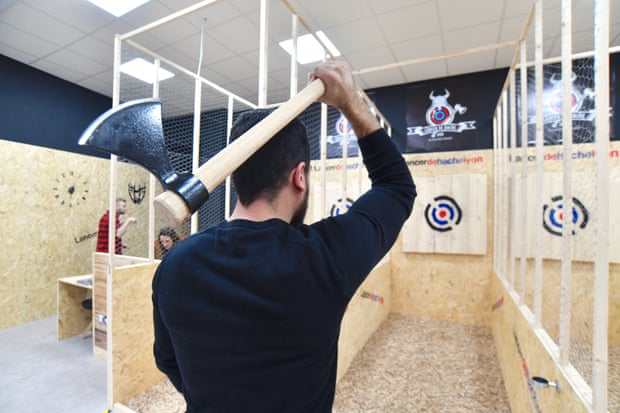Make Memories at Denver Axe Throwing: Tips for a Fun Trip
Make Memories at Denver Axe Throwing: Tips for a Fun Trip
Blog Article
The Enjoyable of Axe Throwing: How This Sport Integrates Ability and Adrenaline for a Fun Time
Axe throwing has arised as an astounding sporting activity that masterfully intertwines the demand for exact skill with the rush of adrenaline, offering participants a one-of-a-kind and appealing experience. The act of tossing an axe in the direction of a target demands concentration and method, at the same time promoting an ambience of camaraderie and pleasant rivalry.
The Origins of Axe Throwing
Axe throwing, a leisure task that has gotten considerable popularity over the last few years, traces its origins back to ancient times. This primal sporting activity go back to early human history, when axes were primarily utilized as tools and tools. The earliest documents of axe usage in competitive contexts are discovered amongst the Celts and Vikings, that threw axes for sport in addition to in combat training. The technique was not merely a leisure activity however a crucial ability for survival and warfare.
Medieval European warriors, specifically throughout the Middle Ages, exercised axe throwing as component of their martial training. The Francisca, a kind of throwing axe utilized by the Franks, became legendary for its dangerous accuracy. This typical weapon was designed to be thrown at adversary guards and shield, showcasing its double energy in both sport and battle.
In even more current history, axe tossing saw a revival in the logging camps of The United States and copyright in the 20th and 19th centuries. Lumberjacks would participate in friendly competitors, testing their precision and strength by focusing on wooden targets. This advancement from a survival skill to a recreational task has led the method for its modern resurgence, with specialized venues and organizations currently commemorating the sport around the world.
Equipment You Need
Recognizing the rich history of axe throwing enhances the admiration of the sporting activity's modern model. For competitive and leisure axe tossing, the most frequently used type is the hatchet, normally evaluating between 1.25 to 2 extra pounds with a handle length of about 16 inches.
Equally important is the target. Regulation targets are constructed from wood, with softwood selections like ache or cottonwood being chosen for their ability to hold the axe and soak up. The target is normally separated into 5 concentric circles, each with a particular point value, to promote scoring.
Safety gear, however typically neglected, is vital. Protective gloves can enhance hold and prevent sores, while closed-toed footwear are a should to safeguard feet from gone down axes (axe throwing denver). Lastly, a well-lit, large tossing area, full with safety and security barriers, makes certain a regulated environment where participants can focus on developing their skills.
Basic Techniques Explained
Grasping the essential methods of axe throwing is crucial for both safety and effectiveness. The very first method to comprehend is the grip. Hold the axe with a company, yet relaxed grip, similar to holding a golf club. The leading hand needs to be placed straight below the axe head, while the non-dominant hand sustains the end of the manage.
Following, focus on the stance. Stand with your feet shoulder-width apart, ensuring your body is stabilized. Your leading foot must be slightly onward, straightening with your target. This positioning help in maintaining stability and routing power properly in the direction of the target.
Safety First
Making certain safety in axe throwing is extremely important to producing an injury-free and satisfying experience. Security measures start with the venue format. A well-designed axe throwing facility functions clear separations between throwing lanes, tough backdrops to capture stray axes, important source and non-slip flooring to stop accidents. Additionally, sufficient lighting is vital to aid participants maintain aesthetic accuracy and spatial recognition.
Advantages of Axe Throwing
Axe throwing offers a myriad of advantages that prolong beyond easy leisure. The repeated motion of tossing the axe also boosts hand-eye coordination and great motor skills.
Emotionally, axe throwing needs precision, technique, and focus, making it an outstanding method to hone cognitive skills. The concentration needed to strike the target can function as a type of mindfulness, allowing individuals to clear their minds and decrease anxiety. This psychological engagement can be particularly valuable in helping individuals establish much better analytic abilities and mental resilience.
Socially, axe throwing is commonly enjoyed in group setups, cultivating team-building and camaraderie. Whether as part of a company occasion or a casual getaway with friends, the sport encourages interaction and partnership. Furthermore, the communal experience of finding out and enhancing together can reinforce relationships and produce long lasting memories.
Conclusion

The earliest documents of axe use in competitive contexts are found amongst the Celts and Vikings, who threw axes for sport as well as in fight training. Release the axe when your hands are approximately at eye level, permitting the axe's all-natural rotation to direct it in the direction of the target.
A properly designed axe tossing facility features clear separations in between find out here now throwing lanes, sturdy backgrounds to catch roaming axes, and non-slip floor covering to protect this link against mishaps. Participants must be instructed on the correct means to manage and toss the axe, highlighting regulated, intentional movements over forceful tosses.
In recap, axe throwing stands out as a sport that masterfully integrates precision, ability, and adrenaline.
Report this page